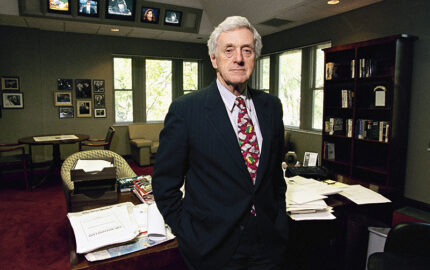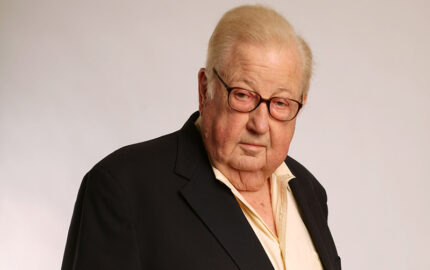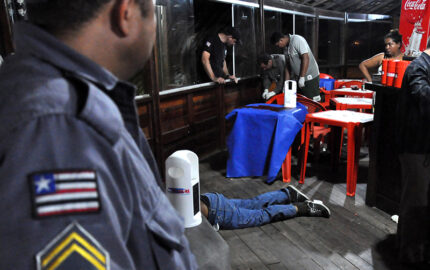 Investigative reporters have long followed the money trail as a reliable way of getting at the core of a story. These days, Fred Pearce, former news editor at New Scientist, takes that advice and uses it in a different era of environmental reporting as “follow my stuff.” From his morning coffee beans to his dinner of prawns, from his socks to sweatshirts, in Eco-Sinner: Tracking Down the Sources of My Stuff,” Pearce takes readers on what turns out to be a 100,000-mile round-the-world odyssey of discovery and often dismay.
Investigative reporters have long followed the money trail as a reliable way of getting at the core of a story. These days, Fred Pearce, former news editor at New Scientist, takes that advice and uses it in a different era of environmental reporting as “follow my stuff.” From his morning coffee beans to his dinner of prawns, from his socks to sweatshirts, in Eco-Sinner: Tracking Down the Sources of My Stuff,” Pearce takes readers on what turns out to be a 100,000-mile round-the-world odyssey of discovery and often dismay.His exploration of the origins of the stuff he uses in his daily life isn’t pretty. From the ravaging of the Aral Sea to the sweatshops of Dhaka in Bangladesh to the wholesale slaughter of fetus-bearing sharks in a national park in the West Africa’s Mauritania, the guilt this eco-sinner expresses for the stuff he has—as do so many other Americans—flows large. Readers, too, are left feeling guilty and shamed by the consumptive society in which they live.
Pearce’s journey is the kind of undertaking that no modern newsroom could realistically afford to embark on from the perspective of staff time and resources. Think travel budget, alone. Yet his message, delivered with unerring and unending certainty, should not be missed by those of us who report on the toll that our materialistic lifestyle as eco-sinners is taking on our planet and its resources and people. Even if the expansiveness of Pearce’s reporting effort cannot be replicated by a single news organization, certainly there are ways to use digital resources and collaborative reporting efforts with journalists spread throughout the world to keep on top of this ever-advancing story.
Chemical Toxins and Children
 Veteran environmental reporter Philip Shabecoff, writing with his wife, Alice, has also written a book,“Poisoned Profits: The Toxic Assault of Our Children,” which speaks to the “total body burden” of chemicals applied specifically to children. This book draws on an extensive and growing scientific literature pointing to detectable levels of a wide range of modern manmade chemicals in fetuses and young children.
Veteran environmental reporter Philip Shabecoff, writing with his wife, Alice, has also written a book,“Poisoned Profits: The Toxic Assault of Our Children,” which speaks to the “total body burden” of chemicals applied specifically to children. This book draws on an extensive and growing scientific literature pointing to detectable levels of a wide range of modern manmade chemicals in fetuses and young children.“We and our children are exposed to toxins invisibly, stealthily, without our knowledge,” the Shabecoffs instruct at one point. “Trillions of pounds of tens of thousands of toxic chemicals pour into the environment and into the products in our homes, workplaces, and schools, and their number is growing daily. There is no place to hide from them.” Our children, they continue, “are not safe in their homes, in their yards or playgrounds, or in their schools. They are not safe in their mother’s womb.”
With the Shabecoffs’ 354-page hardback, the chapter titles provide an easy roadmap and a handy snapshot of the “Perry Mason/Law and Order/crime story” strategic design that lies behind their book:
“Inquest”
“Indictment”
“Victims”
“Evidence”
“Scene of the Crime”
“Forensics”
“Perpetrators”
“Co-Conspirators”
“Witness for the Defense”
“Posse Comitatus”
“Values”
“Justice”
In using this crime-story approach to their work, they write, “we do not mean that these crimes are the kind punishable under our current criminal justice system, although in some cases they may be. Our terms are a metaphor, not a formal allegation.” While they pay what seems mandatory homage to the point that modern chemicals have brought with them many of the qualities identified with the high standard of living enjoyed by many Americans, the Shabecoffs leave little doubt that they are not persuaded that the benefits outweigh the risks.
Their book speaks to the reality that insufficient data, for a number of reasons, tends to undermine even the most well-intended attempts at precautionary safety and health rule-making. They write that “Whatever the reason, the absence of data is not proof of safety. The absence of data proves only ignorance.” Writing elsewhere in the book, they explain why in the minds of many “proof remains elusive, still around the corner,” and offer two reasons why this is so. “One is the scientific method itself. The other is the financial self-interest and ideology that purposely cultivate uncertainty.”
“Without divine wisdom, absolute proof is rarely possible,” the Shabecoffs acknowledge. “After our years of research for this book, however, we strongly conclude that a sufficient weight of evidence is attainable and actionable ‘proof’ is available.”
Books About Climate Change
If it is proof of a warming climate and humankind’s influence on global warming that one is looking for, the gold standard is the series of sequential reports and analyses produced by the Nobel Prize-winning Intergovernmental Panel on Climate Change (IPCC), established by the United Nations and the World Meteorological Organization. Given the nature of these technical treatises, it’s not surprising that those trained in journalism have lent their skills to the job of improving public understanding.
 Andrew C. Revkin covers the climate story for The New York Times, and he has written books and blog posts about emerging climate science and the debates surrounding it. His closely-followed blog (dotearth.blogs.nytimes.com) generates scores of responses of real substance and substantial merit from a wide range of climate science academics, wonks, and partisans. Along with his Science Times’ pieces and news articles, Revkin wrote “The North Pole Was Here” aimed at a youthful audience of readers on whose shoulders the burdens and challenges of a warming climate inevitably will lie. [See Nieman Reports, Fall 2006, for a review of Revkin’s book, www.niemanreports.org.]
Andrew C. Revkin covers the climate story for The New York Times, and he has written books and blog posts about emerging climate science and the debates surrounding it. His closely-followed blog (dotearth.blogs.nytimes.com) generates scores of responses of real substance and substantial merit from a wide range of climate science academics, wonks, and partisans. Along with his Science Times’ pieces and news articles, Revkin wrote “The North Pole Was Here” aimed at a youthful audience of readers on whose shoulders the burdens and challenges of a warming climate inevitably will lie. [See Nieman Reports, Fall 2006, for a review of Revkin’s book, www.niemanreports.org.] Two other journalists, Ross Gelbspan and Eugene Linden, also rely on books to tell stories of climate change in ways they weren’t able to do as news reporters. Gelbspan’s “The Heat is On: The High Stakes Battle over Earth’s Threatened Climate” is a bare-knuckles advocacy-oriented call to action and widely regarded as contributing to a seminal turning point in how many journalists approach the issue of “balance” when considering IPCC’s findings when challenged by a smaller but very vocal minority. Gelbspan no longer considers himself a news reporter; on this issue, he’s become an advocate and activist. [See Gelbspan’s article in Nieman Reports’ collection of stories about climate change coverage in the Winter 2005 issue.]
Two other journalists, Ross Gelbspan and Eugene Linden, also rely on books to tell stories of climate change in ways they weren’t able to do as news reporters. Gelbspan’s “The Heat is On: The High Stakes Battle over Earth’s Threatened Climate” is a bare-knuckles advocacy-oriented call to action and widely regarded as contributing to a seminal turning point in how many journalists approach the issue of “balance” when considering IPCC’s findings when challenged by a smaller but very vocal minority. Gelbspan no longer considers himself a news reporter; on this issue, he’s become an advocate and activist. [See Gelbspan’s article in Nieman Reports’ collection of stories about climate change coverage in the Winter 2005 issue.] More scholarly in its approach—though no less determined and committed in his battle to confront manmade climate change—is “The Winds of Change: Climate, Weather, and the Destruction of Civilizations,” written by former Time writer Eugene Linden. He provides an insightful historical look at climate and weather in the vein of evolutionary biologist Jared Diamond’s 1998 Pulitzer Prize-winning “Guns, Germs, and Steel.”
More scholarly in its approach—though no less determined and committed in his battle to confront manmade climate change—is “The Winds of Change: Climate, Weather, and the Destruction of Civilizations,” written by former Time writer Eugene Linden. He provides an insightful historical look at climate and weather in the vein of evolutionary biologist Jared Diamond’s 1998 Pulitzer Prize-winning “Guns, Germs, and Steel.”Using his keen eye, photojournalist Gary Braasch, in his 2007 book “Earth Under Fire: How Global Warming is Changing the World” offers spectacular images shot from across the warming world. Combined with his skillful reporting, Braasch’s images and words take readers well beyond the “coffee table book.” With work on this topic dating back nearly two decades, Braasch writes that “As a journalist, I wanted to move beyond the raw statistics, the
 secondhand and political arguments, and talk directly to the scientists who are documenting the change….It is clear to me that I am documenting a decisive, overarching event of the 21st century—one with no equal in the previous centuries of human civilization.” And with author Lynne Cherry, Braasch also produced, like Revkin, a book geared to today’s youth: “How We Know What We Know About Our Changing Climate: Scientists and Kids Explore Global Warming.” [See Braasch’s photo essay from the Arctic in the Winter 2002 issue of Nieman Reports.]
secondhand and political arguments, and talk directly to the scientists who are documenting the change….It is clear to me that I am documenting a decisive, overarching event of the 21st century—one with no equal in the previous centuries of human civilization.” And with author Lynne Cherry, Braasch also produced, like Revkin, a book geared to today’s youth: “How We Know What We Know About Our Changing Climate: Scientists and Kids Explore Global Warming.” [See Braasch’s photo essay from the Arctic in the Winter 2002 issue of Nieman Reports.] With so many books being published on the subject of climate change, Penn State University climatologist Michael E. Mann and co-author Lee R. Kump must have thought hard about how to approach their 2008 book “Dire Predictions: Understanding Global Warming—The Illustrated Guide to the Findings of the IPCC.” Full of stunning and scientifically smart and informative graphics, the authors worked with a publisher, DK Publishing, a part of Pearson Education, widely regarded as “information architects.” Like Braasch’s book, this one begs the reader to return often to explore various sections, to confirm a suspicion or to dispel a rumor.
With so many books being published on the subject of climate change, Penn State University climatologist Michael E. Mann and co-author Lee R. Kump must have thought hard about how to approach their 2008 book “Dire Predictions: Understanding Global Warming—The Illustrated Guide to the Findings of the IPCC.” Full of stunning and scientifically smart and informative graphics, the authors worked with a publisher, DK Publishing, a part of Pearson Education, widely regarded as “information architects.” Like Braasch’s book, this one begs the reader to return often to explore various sections, to confirm a suspicion or to dispel a rumor. Writing books about environmental issues inevitably invites comparison with what many view as the cornerstone of environmental writing—Rachel Carson’s “Silent Spring.” It’s a comparison that most environmental authors do well not to invite. Still, such long-form books hold a special place in today’s fast-paced digital era. They provide a force of their own in explaining well the myriad threats facing our humble Earth and the very real threats to its human, animal, and plant citizens.
Writing books about environmental issues inevitably invites comparison with what many view as the cornerstone of environmental writing—Rachel Carson’s “Silent Spring.” It’s a comparison that most environmental authors do well not to invite. Still, such long-form books hold a special place in today’s fast-paced digital era. They provide a force of their own in explaining well the myriad threats facing our humble Earth and the very real threats to its human, animal, and plant citizens.Bud Ward is editor of The Yale Forum on Climate Change & The Media, a freelance writer and journalism educator, and jury administrator for The Grantham Prize for Excellence in Reporting on the Environment. He is the author of the National Science Foundation-funded book “Communicating on Climate Change: An Essential Resource for Journalists, Scientists, and Educators.”


